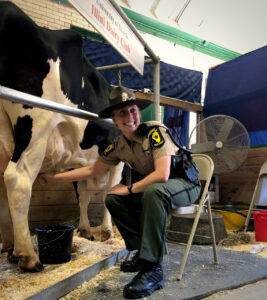
Trooper Haylie Polistina, from the Illinois State Police Public Information Office, at the Illinois State Fair. Photo by John Griswold
The Illinois State Fair was canceled in 2020, for the pandemic, and for years before that I was living elsewhere. As we walked across the Fairgrounds yesterday to meet the rest of our family, my younger son asked if I knew where I was going. Of course I did.
When I was a teen, about his age, I worked with interpretive park rangers, from Giant City State Park, in the Conservation World area of the State Fair. The rangers stayed at night in a motel with the snakes we were there to display; I stayed with my sister and brother-in-law at their house in Springfield. Working on the fairgrounds and walking home after work was a great adventure, and the layout of the Fair was imprinted deeply.
Elsewhere in America things have changed completely—it has been more than 40 years, after all—but yesterday I felt like a bird sure in the electromagnetic field that my sense of navigation would still work. And it did. Conservation World is still on the northwest corner of the grounds, and the big tent we used to work in was still there, in the same footprint, still housing snake exhibits for educating the public on native species.
All the exhibition halls—prairie-brick temples to agriculture—are still there, of course, as are the less-imposing animal barns, filled on this third day of the Fair with sheep, pigs, and horses being judged. All the same hardworking 4-H and FFA kids are there, now grandchildren of the ones I remembered. The air is fragrant with pig shit and fried sweetened dough. The streets are laid out on the same grid and are lined with the same types of food stalls. It was a surprise that some even have the same vendors’ names on them.
Fair food everywhere verges on the mythological, for good and bad reasons, and each new visit is measured against that. My corn dog was at about 80% mythological goodness, and the lemon shakeup was not shaken in front of us: bad form. The Pork T sandwich—a delicious crispy schnitzel with pickles, mustard, and ketchup, from the pork lobby—had gone missing in the years. I do not remember seeing a fiddlestick.
No one I was with ordered the jumbo shrimp or funnel cake or turkey leg or the bag of donuts, but they were available. All the cynical fry-ups had come on the scene years back: deep-fried Snickers bars and the lot. The new one to me was the Hot Meat Sundae.
The perversity of the food seems like an effort to keep some of the old-school carnie atmosphere. In the ‘70s, there were still freak shows on the midway—I remember a barker shouting about a three-breasted woman who had appeared in Playboy—and there was always that one guy in the dunking booth, in hobo clothes and depression-era clown makeup, who said awful things to kids trying to concentrate on their throws, such as, “How do you pick that nose, boy? With a fork?”
But a large part of the draw is the animals, the OGs many city kids no longer get to see in person. “Dude, I petted a pig,” my son said. Then he petted a goat, a duck, a chick, and a sheep. “I’m never washing this hand again,” he said.
It was hot; of course it was hot. After a long heatwave in the Midwest, a violent thunderstorm midweek had offered relief, and everyone said happily that the rest of the month would be in the lower 80s. But it is August in central Illinois, so it was still in the upper 80s, and the humidity and sun made it feel like 95. We were dripping as we raced around trying to get everything done on my son’s bucket list. (Rock wall, Sky Ride, milk a cow.)
Flaubert had a great time puncturing the provinciality of the agricultural fair, but it is one of those things we will wax nostalgic on at the end of the world My son said it was epic, that it just hit. He said this is what kids are meant to be doing in summer, not gaming. Of course it is very much as it was in my own childhood, when we had no games. This is a kind of miracle, that the Fair does not feel like a decaying relic or a Disney-fied recreation, though at one point Abe Lincoln passed in a golf cart with his handlers.
“Mr. President!” I called. He gave me a giant, modern, orthodontical smile and made a pistol at me with his fingers.
I saw nothing digital except a camera in front of a green-screen, for visitors to take a commemorative photo of themselves by the Butter Cow. The device was out of order.
My son got his experience milking a cow, in the place where I probably milked my first cow, an animal barn occupied by the University of Illinois Illini Dairy Club. He was a natural.
As we stood there, two women in Illinois State Police uniforms came through the door, Smokey Bear hats pulled low at the proper angle, no-nonsense, asking the price to milk a cow and where they should go to do that.
This was Sergeant December Melville, the ISP Central Recruitment Coordinator, and Trooper Haylie Polistina, from the Public Information Office. The sergeant mistook my son for a Dairy Club member and pointed at one of two enormous cows lying side-by-side in hay.
“Is this your animal?” she said.
I laughed, because her tone suggested, Is this your vehicle? You’ll have to move it. In another minute everything was straightened out, and the officers approached the cow in question, a Holstein named Betty, standing in a stanchion.
“Let’s go,” Sergeant Melville said, sitting on the milking stool. “Do I need some instructions on this, or what?”
